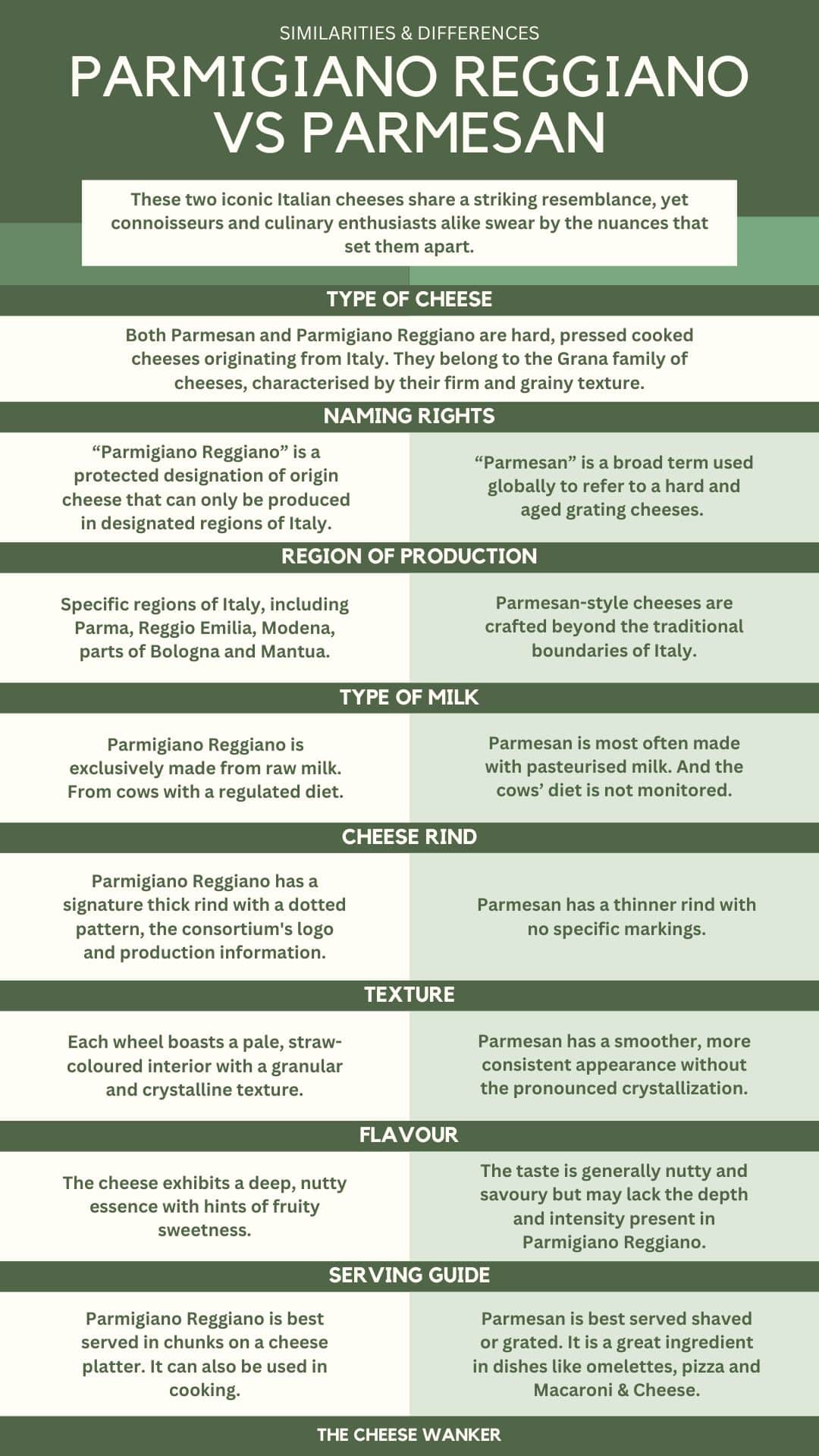Introduction To Asiago Cheese And Parmesan

Asiago Cheese and Parmesan are two popular Italian cheeses known for their rich and distinct flavors. Asiago Cheese is named after the region in which it is produced, the Asiago plateau in northern Italy. It is made from cow’s milk and has a slightly buttery, creamy, and nutty taste with a noticeable bitterness. Parmesan, also known as Parmigiano Reggiano, is made from raw cow’s milk and has a sharper and more robust flavor, with hints of fruitiness and earthiness. Both cheeses are widely used in various culinary dishes and offer unique taste experiences.
Overview Of Asiago Cheese
Asiago Cheese, named after the region in northern Italy where it is produced, is a popular Italian cheese known for its rich and distinct flavors. Made from cow’s milk, it has a slightly buttery, creamy, and nutty taste with a noticeable bitterness. The cheese is aged for different periods of time, resulting in varying degrees of flavor and texture. Younger Asiago cheeses have a smooth and mild taste, while aged Asiago cheeses develop a sharper and more pronounced flavor. This versatile cheese is often used in cooking and is a favorite among cheese enthusiasts.
Overview Of Parmesan Cheese
Parmesan cheese, also known as Parmigiano-Reggiano, is a renowned Italian cheese with a long history. It is made from cow’s milk and aged for a minimum of 12 months, resulting in its unique flavor and texture. Parmesan cheese has a distinct nutty, savory, and slightly tangy taste, making it a favorite for grating over pasta dishes or salads. It has a hard, granular texture and is easily crumbled or shaved. Parmesan cheese is highly regarded for its rich umami flavor and is often considered a staple ingredient in Italian cuisine.
Asiago Cheese: Taste And Texture

Asiago cheese is known for its distinct taste and texture. It has a nutty and creamy flavor that becomes sharper as it ages. The taste can vary depending on the age of the cheese, ranging from mild and buttery to more intense and tangy.
In terms of texture, Asiago cheese can range from smooth and creamy when young, to more firm and crumbly as it ages. The older varieties of Asiago cheese have a drier texture, making it perfect for grating or shaving. Its versatility allows it to be enjoyed in various dishes, both melted and grated.
Flavor Profile Of Asiago Cheese
Asiago cheese is known for its distinct flavor profile. It has a nutty and creamy taste that becomes sharper and more intense as it ages. The younger Asiago cheese has a mild and buttery flavor, while the aged varieties develop a tangy and robust taste. This cheese also has a hint of sweetness, which adds depth to its overall flavor. The combination of its nutty, creamy, and tangy elements makes Asiago cheese a versatile ingredient in various dishes. From salads to pasta, Asiago cheese adds a unique and delicious flavor to any recipe.
Texture Characteristics Of Asiago Cheese
Asiago cheese has a firm and dense texture, similar to Parmesan. However, it is slightly smoother and creamier. The texture can vary depending on the age of the cheese. Younger Asiago cheese has a softer and more supple texture, while aged Asiago cheese becomes crumbly and granular. This unique texture adds a pleasant mouthfeel to dishes and allows the cheese to melt beautifully when heated. Whether grated, shredded, or sliced, the texture of Asiago cheese adds a delightful element to a wide range of culinary creations.
Parmesan Cheese: Taste And Aroma

Parmesan cheese is renowned for its distinct flavor and aroma. It has a rich, intense, and slightly salty taste that is often described as nutty and savory. The aging process of Parmesan cheese develops its unique flavor profile, with older varieties having a more robust and complex taste. Parmesan cheese also has a strong, pleasant aroma, which is reminiscent of cooked caramel and roasted nuts. These distinct taste and aroma profiles make Parmesan cheese a popular choice for grating over pasta dishes, salads, and soups, adding a burst of flavor to any meal.
Flavor Profile Of Parmesan Cheese
Parmesan cheese is known for its distinct and intense flavor. It has a rich, nutty, and slightly salty taste that is often described as savory. The aging process of Parmesan cheese gives it a complex and robust flavor profile. As it matures, the cheese develops notes of caramel and roasted nuts, adding depth to its taste. Parmesan cheese’s flavor is bold and can greatly enhance the overall taste of any dish it is added to. This strong flavor profile makes Parmesan cheese a favorite choice for grating over pasta, risotto, and salads.
Aroma Characteristics Of Parmesan Cheese
Parmesan cheese is renowned for its distinct and enticing aroma. It has a deeply fragrant and nutty scent that is both robust and inviting. The aroma of Parmesan cheese is often described as a combination of toasted nuts and caramelized butter, with hints of earthiness. The aging process of Parmesan enhances these aromatic qualities, creating a complex and alluring scent that can elevate any dish it is used in. The aroma of Parmesan cheese adds depth and intensity to the overall sensory experience, making it a beloved ingredient in various culinary creations.
Culinary Uses Of Asiago And Parmesan

Asiago and Parmesan cheeses are both incredibly versatile and can be used in a variety of culinary creations. Here are some ways to use these Italian cheeses:
- Asiago Cheese:
- Shredded Asiago can be sprinkled on top of pasta dishes or salads for a burst of flavor.
- Melted Asiago is great for adding richness to sauces, soups, and risottos.
- It can be used in sandwiches, wraps, or paninis for a delicious cheesy filling.
- Grated Asiago is perfect for topping pizzas or baked dishes, adding a nutty and tangy flavor.
- Parmesan Cheese:
- Grated Parmesan is a classic topping for pasta dishes, such as spaghetti or lasagna.
- It can be used to garnish soups, like minestrone or tomato soup, for added depth of flavor.
- Parmesan can be sprinkled over roasted vegetables or salads to enhance their taste.
- It can also be used in breading for chicken or fish, providing a crispy and savory coating.
Both cheeses can be enjoyed on their own or combined with other ingredients to elevate the flavor of various dishes. Their distinct characteristics make them essential ingredients in Italian cuisine and beyond.
Ways To Use Asiago Cheese In Dishes
Asiago cheese is incredibly versatile and can be used in a variety of dishes to enhance their flavor. Here are some creative ways to use Asiago cheese:
- Sprinkle shredded Asiago on top of pasta dishes or salads for a burst of flavor.
- Melt Asiago to add richness to sauces, soups, and risottos.
- Use Asiago in sandwiches, wraps, or paninis for a delicious cheesy filling.
- Grate Asiago and sprinkle it over pizzas or baked dishes for a nutty and tangy flavor.
The distinct taste and texture of Asiago cheese make it a perfect addition to various recipes, adding depth and richness to any meal.
Creative Ways To Use Parmesan Cheese In Cooking
Parmesan cheese is a versatile ingredient that can elevate the flavor of many dishes. Here are some creative ways to incorporate Parmesan cheese into your cooking:
- Make a savory Parmesan crust for roasted meats or vegetables by combining grated Parmesan cheese with breadcrumbs and herbs.
- Create a creamy and flavorful Parmesan sauce by melting grated Parmesan cheese into a mixture of butter, cream, and garlic.
- Sprinkle grated Parmesan cheese on top of roasted or steamed vegetables for added texture and savory taste.
- Use Parmesan cheese as a garnish for soups and salads, adding a salty and nutty flavor to your dish.
- Make homemade Parmesan crackers by combining grated Parmesan cheese with flour, butter, and spices, then baking them until crispy.
These creative uses of Parmesan cheese will surely enhance the taste and texture of your dishes, making them even more delicious.
Health Benefits Of Asiago And Parmesan

Both Asiago and Parmesan cheeses come with their own set of health benefits.
Asiago cheese is a good source of calcium, essential for maintaining strong bones and teeth. It also contains phosphorus, which aids in proper cell function and energy production. Additionally, Asiago cheese provides protein, helping to build and repair tissues.
Parmesan cheese is rich in calcium and protein as well. Calcium contributes to bone health and plays a crucial role in muscle function. Protein is essential for growth and repair of body tissues.
Incorporating Asiago and Parmesan cheeses into your diet can be a delicious way to boost your intake of these important nutrients.
Nutritional Value Of Asiago Cheese
Asiago cheese is a nutritious option for cheese lovers. It is a good source of calcium, which is essential for maintaining strong bones and teeth. It also provides protein, which is important for building and repairing tissues. Asiago cheese contains phosphorus, supporting proper cell function and energy production. Additionally, it offers vitamins such as vitamin A, B2, and B12. Incorporating Asiago cheese into your diet can be a delicious way to boost your intake of these important nutrients.
Health Benefits Associated With Consuming Parmesan Cheese
Parmesan cheese offers numerous health benefits when consumed as part of a balanced diet. It is a rich source of protein, which is essential for muscle growth and repair. The high calcium content in Parmesan cheese promotes healthy bones and teeth. Additionally, Parmesan cheese contains phosphorus, necessary for energy production and cell function. It also provides vitamin A, which supports good vision and immune function. Incorporating Parmesan cheese into meals can enhance the nutritional value and add a burst of flavor. However, moderation is key due to its high sodium content.
Conclusion

In conclusion, Asiago Cheese and Parmesan Cheese are both delicious and versatile Italian cheeses that offer distinct flavors and textures. Asiago is known for its mild and nutty taste, while Parmesan has a rich and savory flavor. Both cheeses can be used in a variety of dishes, adding depth and complexity to your meals. When choosing between Asiago and Parmesan, consider the specific flavor and texture profiles you desire. Whether grated over pasta or melted into sauces, both cheeses are sure to elevate your culinary creations.
Comparison Of Asiago Cheese And Parmesan Cheese
Asiago Cheese and Parmesan Cheese are both popular Italian cheeses, but they have distinct differences in terms of flavor, texture, and culinary uses.
In terms of taste, Asiago Cheese has a mild and nutty flavor that becomes sharper with age, while Parmesan Cheese has a rich and savory taste with a hint of saltiness.
Texture-wise, Asiago Cheese can range from smooth and creamy to crumbly, depending on its age, while Parmesan Cheese is known for its crumbly and granular texture that is perfect for grating.
Both cheeses can be used in a variety of dishes, but Asiago is often used in pasta, salads, and sandwiches, while Parmesan is commonly grated over pasta, risotto, and soups.
Overall, while both cheeses are delicious and versatile, choosing between Asiago and Parmesan depends on personal preference and the specific flavor and texture profile desired in a dish.
Recipe Ideas Using Asiago And Parmesan Cheeses
Some delicious recipe ideas using Asiago and Parmesan cheeses include:
- Asiago and Parmesan Risotto: Creamy and flavorful, this dish combines the nuttiness of Asiago cheese with the richness of Parmesan for a comforting meal.
- Baked Asiago and Parmesan Chicken: Coat chicken breasts with a mixture of shredded Asiago and Parmesan cheeses, breadcrumbs, and herbs, then bake until golden and crispy.
- Asiago and Parmesan Pasta Salad: Toss cooked pasta with a dressing made from olive oil, lemon juice, garlic, and grated Asiago and Parmesan cheeses, then add in your favorite vegetables and herbs for a refreshing side dish.
- Roasted Vegetables with Parmesan and Asiago: Toss a variety of vegetables with olive oil, salt, and pepper, then sprinkle with a mixture of grated Parmesan and Asiago cheeses before roasting until tender and caramelized.
- Flatbread with Asiago and Parmesan: Top homemade or store-bought flatbread with a mixture of sliced Asiago and Parmesan cheeses, fresh herbs, and your choice of toppings, then bake until the crust is crispy and the cheese is melted and golden. Enjoy these delightful recipes that showcase the unique flavors of Asiago and Parmesan cheeses.
FAQ About Asiago Cheese Vs Parmesan: Comparing Italian Cheeses
Q: What is the main difference between Asiago and Parmesan cheese?
A: The main difference lies in their taste and texture. Asiago has a milder, nuttier flavor with a smoother texture, while Parmesan has a sharper, more complex flavor with a crumbly texture.
Q: Can Asiago cheese be used as a substitute for Parmesan and vice versa?
A: Yes, both cheeses can be used as substitutes for each other in most recipes. However, the flavor profile and texture may vary slightly, so it’s best to adjust quantities accordingly.
Q: Which cheese is typically more expensive, Asiago or Parmesan?
A: Parmesan cheese is generally more expensive than Asiago due to its longer aging process, which enhances its flavor and texture. Asiago is usually more budget-friendly.
Q: Are Asiago and Parmesan cheeses suitable for lactose-intolerant individuals?
A: Both Asiago and Parmesan cheeses are considered low in lactose and are often tolerated by those with lactose intolerance. However, it’s best to consult with a healthcare provider if you have specific dietary concerns.
Q: How should Asiago and Parmesan cheeses be stored to maintain freshness?
A: The best way to store Asiago and Parmesan cheeses is to wrap them tightly in parchment paper or wax paper, followed by a layer of plastic wrap or aluminum foil. Store them in the refrigerator to maintain their freshness and prevent them from drying out.
Q: Can Asiago and Parmesan cheeses be frozen for later use?
A: Yes, Asiago and Parmesan cheeses can be frozen for up to 6 months. It’s recommended to grate or shred the cheese before freezing to make it easier to use in recipes. Thaw the cheese in the refrigerator before using.

Hot Pot Chinese Restaurant, located in Mechanicsville, MD 20659, is a culinary destination that offers a delightful array of Chinese cuisine. From the cozy ambiance to the delectable dishes, Hot Pot Chinese Restaurant is dedicated to providing an exceptional dining experience for all patrons. Since our establishment, Hot Pot Chinese Restaurant has been committed to serving the finest Chinese food, offering a diverse menu that caters to a wide range of tastes. Whether you’re craving traditional favorites like Kung Pao Chicken and Mongolian Beef or seeking out more adventurous options like Szechuan Spicy Hot Pot, our menu has something to satisfy every craving.